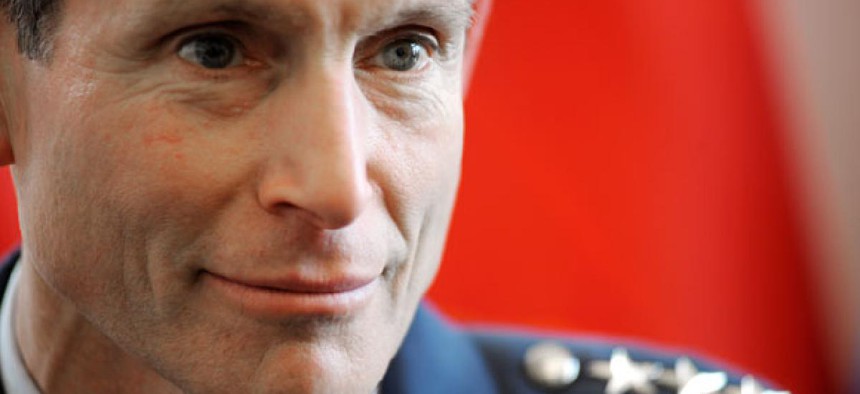Air Force chief talks of shrinking budgets, post-Iraq exhaustion
Key priority is funding operations and maintenance, Gen. Norton Schwartz says.
As it continues downsizing under tightening Defense Department budgets, the Air Force will give priority to operations and maintenance to make sure that “what remains will be ready and available to act,” its chief of staff said.
Gen. Norton Schwartz also told an audience at the Stimson Center, a nonpartisan think tank, that Air Force operations and tactics are clearly better after two major conflicts and counterterrorism efforts, “but you can’t ignore that fact that we are worn down by 10 years of war in terms of human and physical assets.”
Unlike the Army and the Marines, the Air Force has been cutting back assets and personnel for a decade, Schwartz said at the Washington event on Tuesday, noting more than 500 aircraft have been retired and 25,000 airmen have been moved off the rolls.
The service’s budget over the next three to five years will be smaller and will emphasize the capacity to play a larger number of roles rather than specialized ones, according to Schwartz. “But none dare go back to the days of airplanes without engines and weapons without bullets,” he said. While some in the budget debates would stress weapons systems and installations to create jobs, “there is no constituency” for operations and maintenance, he said. “You won’t hear this from titans of industry or veterans associations.”
A key lesson from the post-9/11 era, Schwartz said, is the need for military planners to “be better prepared for the post-conflict” phase, to anticipate such eventualities as the Iraqi insurgency that rose up after Operation Iraqi Freedom, and “to better scope the consequences of action or inaction.”
Citing the “famous question” of Gen. (now CIA director) David Petraeus -- “How does this end?” -- Schwartz said, “Our brightest people need to address this as well as the issues we’re more comfortable with, such as how do I get there and with what resources.”
Asked by Stimson Center Chairman Lincoln Bloomfield Jr. about the ethics of using unmanned drone aircraft to kill al Qaeda terrorists, Schwartz rejected the question’s premise: “Is it more ethical to engage an asset from an F-15 or an F-16 or an [unmanned] M Q9? We have rules of engagement, so if it is a legitimate target, the manner in which we engage that target in close combat is irrelevant.”
The future Air Force will remain strong in four areas, Schwartz said, citing control of air and space; intelligence, surveillance and reconnaissance; global mobility, or “getting shooters to the fight;” and global strike, or the ability to “reach out and touch potential adversaries.” The U.S capacity to operate at a high tempo is a “depth that few others share,” he added.
Also important in the coming decades will be a forward presence overseas to maintain “lily pads,” as he called bases. That involves continuing relationships with key allies, which depends in part on working with the State Department on a new policy on export controls. “There is some tension between short- and long-term legs, but we need both,” Schwartz said.
Asked about congressional proposals heard for greater inter-service sharing of assets, Schwartz said, “History casts some doubt about whether joint major weapons are efficient.” But with the current budget pressures, such collaboration is more likely to unfold, and, “if they are narrow and common enough,” it makes sense, he added.
Responding to moves by the House Armed Services Committee to override Pentagon plans to eliminate some aircraft, Schwartz said, “if you give us the force structure back, give us the money too, for training, exercises and sustainment.”
Asked whether drone aircraft could someday eliminate the need for pilots, he said, “no one in this room will be alive when that happens, if it does. Remote aircraft can’t survive in contested airspace, so we still need a tactical force.”
The chief of staff said the Air Force may already have surpassed the other services in incorporating alternative energy, though the budget crunch toughens the challenge. “It works better in some parts of the country than others,” Schwartz said, noting the base in Las Vegas, Nev., now uses solar-based energy for 10 percent of its requirements, but that such an arrangement would not work in New England.
The Air Force is the world’s largest user of hydrocarbons, Schwartz said, but when it comes to fueling planes with alternative blends, “we’re a consumer, not a producer.” The service can achieve some progress in reducing fuel consumption by using more simulation and altering flight paths. “But the bottom line is, if we’re going to be good and not just say we’re good, we have to continue to fly airplanes,” he said.
NEXT STORY: Taliban announces 'spring offensive'




